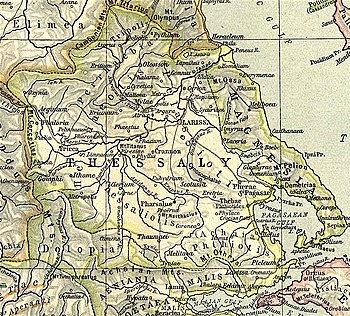Mylae (Thessaly)
39°44′30″N 22°05′17″E / 39.74173°N 22.08809°E

Mylae (Ancient Greek: Μυλαί) was a town and polis (city-state)[1] of Perrhaebia in ancient Thessaly.[2][3] Livy described the battle for the town during the Third Macedonian War, in 171 BCE. The army of Perseus of Macedon, having obtained the surrender of Pythium, Azorus, and Doliche, and having taken Cyretiae, went against the city of Mylae, but it was very well fortified and resisted a siege for three days. On the fourth day, when the defenders were exhausted, the Macedonians launched a stronger attack against the city's defences but the defending Mylaens held them off long enough to counter attack. However, given the Mylaen numerical inferiority, the defence had to be abandoned. The Macedonians were able to penetrate through the breached defences and take the city. The Macedonians subsequantly looted it, and sold it back to the survivors.[2]
Mogens Herman Hansen identifies the site of Mylae as being just north of the modern town of Vlachogianni,[4] while for others the identification with the Vlachogianni site is only tentative.[5][6]
References
[edit]- ^ Mogens Herman Hansen & Thomas Heine Nielsen (2004). "Thessaly and Adjacent Regions". An inventory of archaic and classical poleis. New York: Oxford University Press. pp. 724-725. ISBN 0-19-814099-1.
- ^ a b Livy. Ab urbe condita Libri [History of Rome]. Vol. 42.54.
- ^ Stephanus of Byzantium. Ethnica. Vol. sub voce.
- ^ Mogens Herman Hansen & Thomas Heine Nielsen (2004). "Thessaly and Adjacent Regions". An inventory of archaic and classical poleis. New York: Oxford University Press. p. 724. ISBN 0-19-814099-1.
- ^ Richard Talbert, ed. (2000). Barrington Atlas of the Greek and Roman World. Princeton University Press. p. 55, and directory notes accompanying. ISBN 978-0-691-03169-9.
- ^ Lund University. Digital Atlas of the Roman Empire.
![]() This article incorporates text from a publication now in the public domain: Smith, William, ed. (1854–1857). "Mylae". Dictionary of Greek and Roman Geography. London: John Murray.
This article incorporates text from a publication now in the public domain: Smith, William, ed. (1854–1857). "Mylae". Dictionary of Greek and Roman Geography. London: John Murray.
